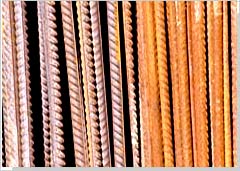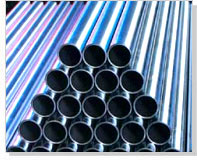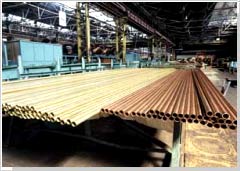 Metal rods are metals and alloys designed in the pattern of round bars or rod, rectangular or flat bars, square bars, hexagons, and other patterns of bar stock. These shapes also come in billet form and generally include a cross-section based on the shape of rod or bar stock. Reinforcing bars are also a type of metal rods that are used to give strength or internally sustain the concrete and masonry structures. Some other forms of metal rods include coil stock and hollow tube stock.
Metal rods are metals and alloys designed in the pattern of round bars or rod, rectangular or flat bars, square bars, hexagons, and other patterns of bar stock. These shapes also come in billet form and generally include a cross-section based on the shape of rod or bar stock. Reinforcing bars are also a type of metal rods that are used to give strength or internally sustain the concrete and masonry structures. Some other forms of metal rods include coil stock and hollow tube stock.
Metal rods can be categorized into different types and categories on the basis of metal used in their construction. Hence on the basis of metal used, metal rods can be categorized into following types -
These different types of ferrous and non-ferrous metal rods are described in brief below -
Ferrous metal rods
Rods made of ferrous metals and alloys are iron based. Some common ferrous metals and alloys used to make rods are carbon steel, stainless steel, alloy steel, cast iron, tool steel, and cast steel. Plain carbon steels are based on iron, carbon, and other alloying elements in small varying amounts. Alloy steel is used in a variety of industrial applications and can be fabricated easily by machining, forming, casting, and welding.
An alloy of carbon and iron, tool steel is known for its high levels of hardening and property alloying elements. The alloy exhibits superior wear resistance, however it is difficult to fabricate in its hardened form. Cast iron is another ferrous metal, which is used in metal rods. An iron alloy, carbon alloy contains high amount of carbon. Cast steel is an alloy, which is produced by pouring molten iron into a mold.
Nonferrous metal rods
Nonferrous metal rods can be defined as rods that do not contain any iron or iron alloys. Some common nonferrous metals that are used to make rods are aluminum, copper, cobalt, nickel, refractory, and titanium. Light in weight, aluminum and its alloys exhibit superior corrosion resistance, ductility, and strength. The metal can be fabricated easily by forming, machining, or welding. Cobalt metal rods are known for their superior strength, toughness, corrosion and oxidation sistance, and temperature strength. Copper, brass, or bronze alloys are known for their superior thermal and electrical conductivity, good corrosion resistance, strength and ductility. Though pure copper is difficult to weld, it has found to be a useful alloying element in aluminum alloys and powder metal-based iron alloys.
Known for their superior strength and toughness, excellent corrosion resistance, and superior raised temperature properties, nickel and nickel alloys are also used in making metal rods. Titanium or titanium alloy metal rods are used in a variety of industrial applications because of their superior corrosion
resistance, high strength-to-weight ratio, and superior fatigue characteristics.
